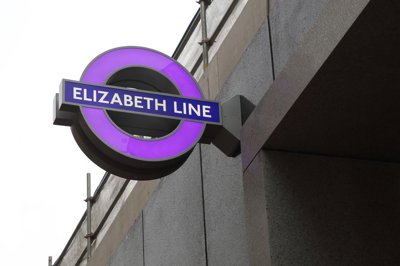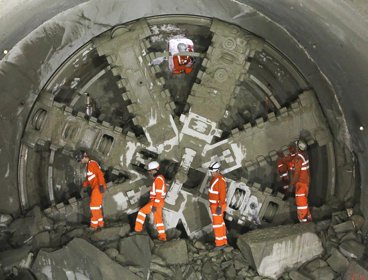Introduction
On 24 May 2022, three and a half years overdue and at least £4 billion over budget, sections of the Elizabeth Line (officially known as Crossrail) were finally opened to passengers. The 73-mile railway line will run from Reading in the west, through central London, out to Essex in the east. The branches in the east will terminate at Shenfield in Essex and Abbey Wood in southeast London, with Reading and Heathrow Airport being the terminals in the west. Ten new stations have been created in London which will directly connect Paddington, Bond Street, Liverpool Street and Canary Wharf.
The new train line will increase London rail capacity by 10% with each train capable of taking 1500 passengers far greater than on the present TfL system. An extra 1.5 million people will be within 45 minutes of central London once the line is fully opened in 2023.

Figure 1 the Elizabeth line © Sign Design Society
The Elizabeth line will reduce journey times across the capital. A journey from Woolwich to Farringdon will take just 14 minutes, whilst Paddington to Canary Wharf will be only 17 minutes.
Work on this very challenging project began in 2009 and at its peak it employed 10,000 workers directly and a further 50,000 people indirectly in the supply chain. It is the biggest UK infrastructure project of a generation, and its development has been met with both praise and criticism.
Map of the Elizabeth line

Figure 2 phase 1 of the Elizabeth line
The Impacts of Crossrail
It is widely reported that Crossrail will add an estimated £42 billion to the UK economy. However, there are also criticisms. A short summary of some of the positives and negatives of Crossrail are listed below in Table 1.
|
Positive |
Negative |
|
The Elizabeth Line will make it easier to travel around and do business in London and the southeast. It will link the capital’s major commercial and business districts (the City and Canary Wharf) to Heathrow, the West End, southeast London, and Essex. This will attract further investment (both domestic and foreign) thereby creating jobs and boosting the regional economy. |
The project focuses infrastructure spending in the southeast to the detriment of the rest of the UK. This is contrary to the Government’s Levelling Up Policy. Transport spending per year in London is £944 per head compared with £314 in the West Midlands. |
|
It is hoped that traffic congestion will be eased benefiting the local environment and businesses in the capital. |
Local councils in northern cities, such as Leeds, Manchester and Liverpool feel that the growth of their economies are hindered by a lack of investment in transport infrastructure. Crossrail therefore widens the North South divide. |
|
The 3.5 million tonnes of earth that were dug up during the construction of stations, and excavated debris from the 13 miles of tunnelling, were transported to Wallesea island at the mouth of the River Thames. A nature reserve has been developed which now attracts a huge number and variety of birdlife. The excavated soil from the project also acts a natural defence against coastal flooding. |
Property prices and rents have soared in places such as Whitechapel and Custom House in east London. As a result, local people who had to put up with the building of the project, have been priced out of the housing rental market and feel that they have benefitted little from the development. Gentrification of the areas by young, professional, mainly white incomers from other parts of London and the UK have made local residents even more marginalised. |
|
It will act as a catalyst for regeneration along the entirety of the route. It is projected that the line will support the delivery of 90,000 new homes around the stations. This extra housing capacity is much needed in the southeast of England. A number of the poorest boroughs in London, such as Tower Hamlets and Newham, have seen a huge rise in investment. It is hoped that deprivation levels will decline in these areas. |
Environmental gains are regarded as questionable by some critics such Professor Whitelegg, Professor of Sustainable Transport at Liverpool John Moores University. He claims that “it would be much better to invest in local integrated networks of buses and cycling [such as the German National Cycling Plan 3.0 for 2030] that will benefit more people, more immediately, at lower cost”. |
Table 1 the pros and cons of Crossrail

